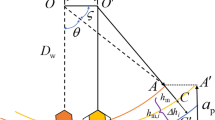Abstract
Abrasive grains on grinding wheel are random in many aspects, such as shapes, attitudes, and positions. The randomness of grains influences greatly in the performance of grinding processes, and it is the difficult part in grinding simulation as well. To overcome this problem, a new method for generating cBN grain model with random shape is proposed in this paper. This method bases on the geometry of cBN grains, and a geometric feature statistic assists in the cBN grain modeling. The randomness of cBN grains in attitudes and positions is considered in the following research. In order to implement the grinding processes prediction, two-dimensional convex hull is used to obtain the projection profiles of random grain shapes. Continuous cutting trajectory of the cutting points is analyzed to simulate the ground surface topography. The algorithm is verified by comparing the results of experiments and the simulations.
Similar content being viewed by others
References
Li S, Liang J, Li L, Cao S, Shu W, Peng H (2003) Study of the ground workpiece surface topography in high-speed precision grinding using a scanning tunneling microscopy. J Mater Process Technol 139:263–266. https://doi.org/10.1016/S0924-0136(03)00232-2
Brinksmeier E, Mutlugünes Y, Klocke F, Aurich JC, Shore P, Ohmori H (2010) Ultra-precision grinding. CIRP Ann Manuf Technol 59:652–671. https://doi.org/10.1016/j.cirp.2010.05.001
Chen X, Brian RW (1995) Analysis and simulation of the grinding process. Part 1: Generation of the grinding wheel surface. Int J Mach Tools Manuf 36:871–882
Koshy P, Jain VK, Lal GK (1997) Stochastic simulation approach to modelling diamond wheel topography. Int J Mach Tools Manuf 37:751–761. https://doi.org/10.1016/S0890-6955(96)00086-7
Darafon A, Warkentin A, Bauer R (2013) 3D metal removal simulation to determine uncut chip thickness, contact length, and surface finish in grinding. Int J Adv Manuf Technol 66:1715–1724. https://doi.org/10.1007/s00170-012-4452-1
Warnecke G, Zitt U (1998) Kinematic simulation for analyzing and predicting high-performance grinding processes. CIRP Ann Manuf Technol 47:265–270. https://doi.org/10.1016/S0007-8506(07)62831-5
Wang X, Yu T, Dai Y, Shi Y, Wang W (2016) Kinematics modeling and simulating of grinding surface topography considering machining parameters and vibration characteristics. Int J Adv Manuf Technol 87:2459–2470. https://doi.org/10.1007/s00170-016-8660-y
Pinto FW, Vargas GE, Wegener K (2008) Simulation for optimizing grain pattern on engineered grinding tools. CIRP Ann Manuf Technol 57:353–356. https://doi.org/10.1016/j.cirp.2008.03.069
Li HN, Yu TB, Da Zhu L, Wang WS (2017) Analytical modeling of ground surface topography in monocrystalline silicon grinding considering the ductile-regime effect. Arch Civ Mech Eng 17:880–893. https://doi.org/10.1016/j.acme.2017.03.010
Cooper WL, Lavine AS (2001) Grinding process size effect and kinematics and numerical analysis. J Manuf Sci Eng.-Trans ASME 122:59–69. https://doi.org/10.1115/1.538888
Hegeman J (2000) Fundamentals of grinding: surface conditions of ground materials groningen: s.n.371–380
De Pellegrin DV, Stachowiak GW (2005) Simulation of three-dimensional abrasive particles. Wear 258:208–216. https://doi.org/10.1016/j.wear.2004.09.040
Nguyen TA, Butler DL (2005) Simulation of precision grinding process, part 1: Generation of the grinding wheel surface. Int J Mach Tools Manuf 45:1321–1328. https://doi.org/10.1016/j.ijmachtools.2005.01.005
Doman DA, Warkentin A, Bauer R (2006) A survey of recent grinding wheel topography models. Int J Mach Tools Manuf 46:343–352. https://doi.org/10.1016/j.ijmachtools.2005.05.013
Zhi G, Li X, Bi W, Tang J, Rong Y (2015) The measurement and analysis of micro bonding force for electroplated CBN grinding wheels based on response surface methodology. Eng Fail Anal 57:377–388. https://doi.org/10.1016/j.engfailanal.2015.04.006
Liu P, Lin B, Yan S, Li Y, Wang B (2016) Numerical simulation and experimental validation of fixed abrasive grinding pad topography. Int J Adv Manuf Technol 83:1253–1264. https://doi.org/10.1007/s00170-015-7643-8
Chi J, Guo J, Chen L (2016) The study on a simulation model of workpiece surface topography in external cylindrical grinding. Int J Adv Manuf Technol 82:939–950. https://doi.org/10.1007/s00170-015-7406-6
Cao Y, Guan J, Li B, Chen X, Yang J, Gan X (2013) Modeling and simulation of grinding surface topography considering wheel vibration. Int J Adv Manuf Technol 66:937–945. https://doi.org/10.1007/s00170-012-4378-7
Zhou X, Xi F (2002) Modeling and predicting surface roughness of the grinding process. Int J Mach Tools Manuf 42:969–977. https://doi.org/10.1016/S0890-6955(02)00011-1
Malkin S (1989) Grinding technology: theory and applications of machining with abrasives. Ellis Horwood, Chichester
Liu Y, Warkentin A, Bauer R, Gong Y (2013) Investigation of different grain shapes and dressing to predict surface roughness in grinding using kinematic simulations. Precis Eng 37:758–764. https://doi.org/10.1016/j.precisioneng.2013.02.009
Nguyen TA, Butler DL (2005) Simulation of surface grinding process, part 2: Interaction of the abrasive grain with the workpiece. Int J Mach Tools Manuf 45:1329–1336. https://doi.org/10.1016/j.ijmachtools.2005.01.006
Funding
The authors would like to thank the Major State Basic Research Development Program of China (2017YFA0701200), the National Natural Scientific Foundation of China (nos. U1508206 and 51275084), the Key laboratory project of Liaoning Province (LZ2015038), and the Science and Technology Planning Project of Shenyang (no.18006001) for the financial support of this work.
Author information
Authors and Affiliations
Corresponding author
Rights and permissions
About this article
Cite this article
Chen, H., Yu, T., Dong, J. et al. Kinematic simulation of surface grinding process with random cBN grain model. Int J Adv Manuf Technol 100, 2725–2739 (2019). https://doi.org/10.1007/s00170-018-2840-x
Received:
Accepted:
Published:
Issue Date:
DOI: https://doi.org/10.1007/s00170-018-2840-x




